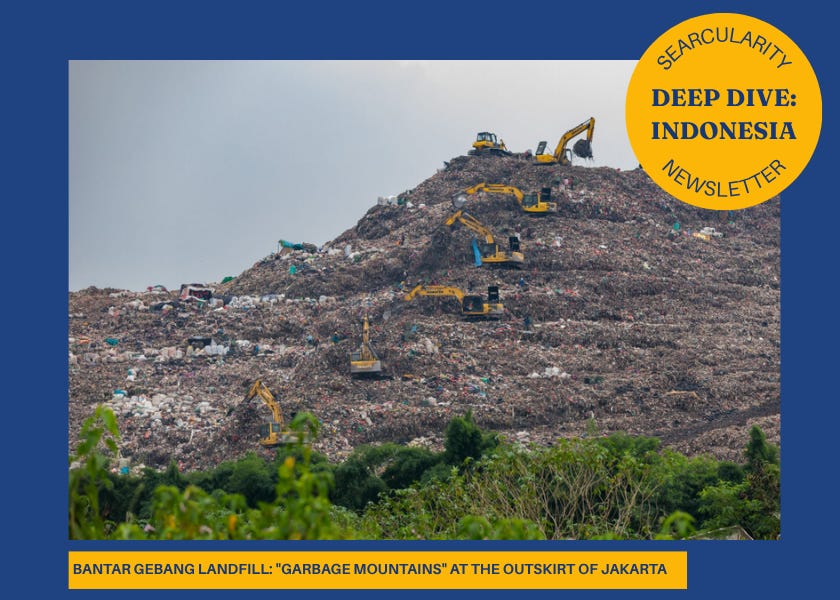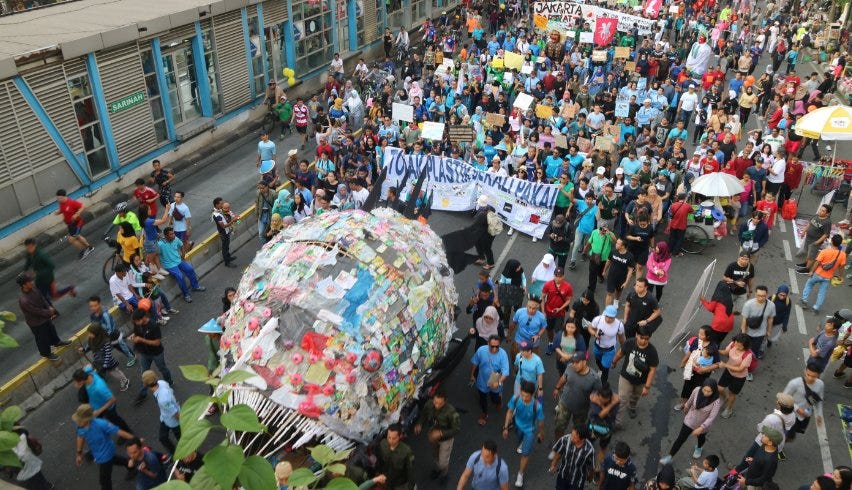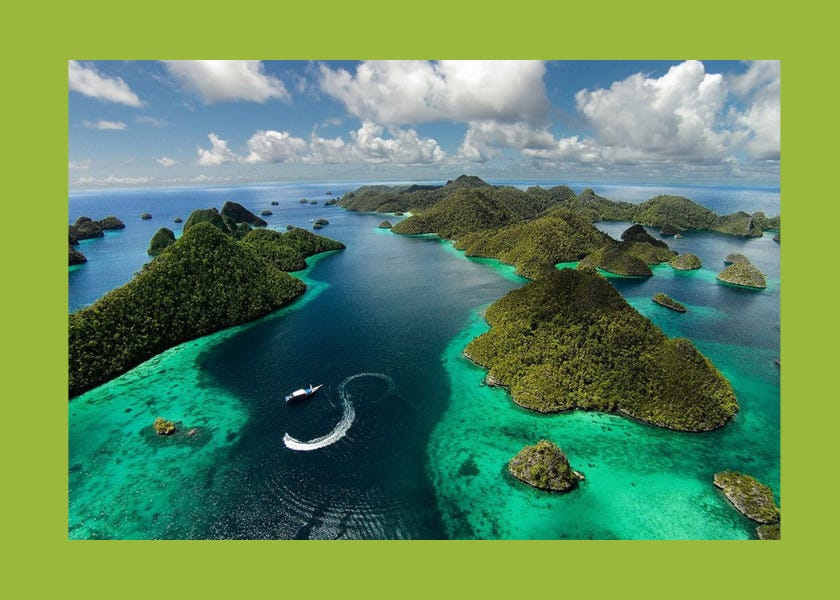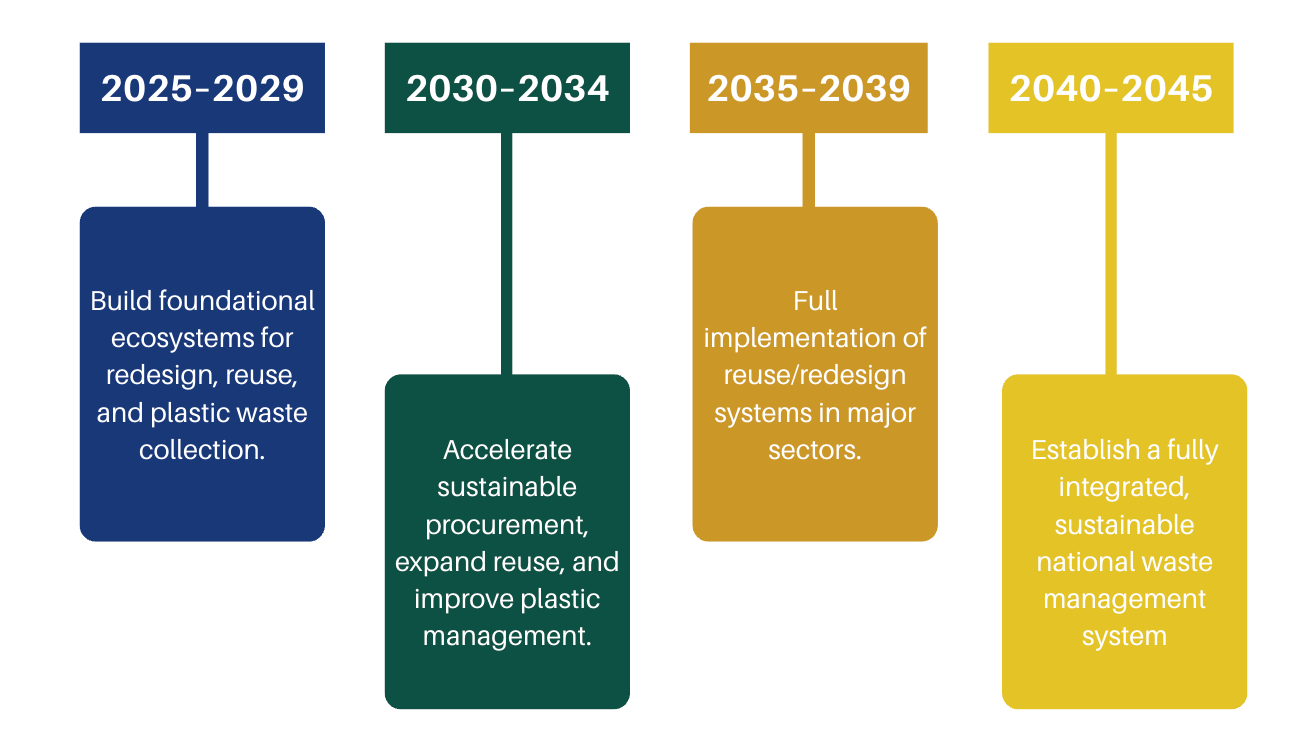Deep dive: Indonesia's circular economy journey
When a national tragedy becomes the catalyst for Southeast Asia's most ambitious waste reform
Welcome to SEArcularity! If you’re new here, you can join our community of 180+ readers and receive our weekly circular economy newsletters in your inbox.
Hey there — Mutiara here! 👋
After my whole rant about capitalism's toxic cycles to perpetuate a consumerist society that just makes us more miserable, I'm back to analysing and diving deep into Southeast Asia's circular economy.
So, this time, we're finally heading to my homeland, Indonesia. 🇮🇩
And honestly? It's pretty damn bad and complicated. 😬
💡Fact: Indonesia actually has National Waste Awareness Day every 21st of February, following a deadly landslide that buried entire communities and left 150 deaths. The reason? Excess rain combined with methane gas buildup due to poor waste management.
Since 2006, the 21st of February has served as an annual rallying cry for better waste practices, community clean-ups, and policy reforms.
It directly led to Indonesia's comprehensive Law No. 18/2008 on Waste Management.
So, waste issues are that bad, huh, in Indonesia? Let's dig into that more.
Indonesia's current waste challenges

🌋 16-storey high mountain of trash: Bantar Gebang, located at the outskirts of Jakarta, is home to Southeast Asia's largest landfill. Around 1,200 trucks dump the waste daily. This sprawling waste disposal has become the home for a vibrant and vulnerable community of 6,000-20,000 people.
🍛 Food waste is the largest component of Indonesia, comprising 39.87% of the country's total generated waste in 2024.
🛍️ An estimated 44% of all plastic waste is mismanaged. Most of it ends up in waterways and oceans.
👗 Textile waste: The textile industry generates an estimated 777,700 tonnes of recyclable textile waste every year and only roughly 40% are recycled.
♨️ Open burning hazard: About 48% of Indonesian households burn their waste openly, a key contributor to air pollution and health risks.
Sounds like a total head-scratcher? Yup.
When your waste management is so bad you literally build mountains taller than most buildings, you know you've got a problem.
National plans to drive Indonesia's circularity
So, what's being done now to solve these challenges?
Recognising the urgency, Indonesia has launched an ambitious policy framework centred on its Circular Economy Roadmap and National Action Plan for 2025–2045.
1. Circular Economy Roadmap & National Action Plan (2025–2045)
⭐️ Vision: Transform Indonesia’s economy by 2045 through a shift from linear to circular, targeting sustainability, innovation, and resilience against global crises (climate, biodiversity loss, pollution).
📊 Priority sectors: F&B, textiles, construction, plastics (with retail packaging), and electronics. Together representing nearly one-third of the national GDP.
🎯 Guiding framework: The 9Rs (Refuse, Rethink, Reduce, Reuse, Repair, Refurbish, Remanufacture, Repurpose, Recycle, Recover) applied across the entire product lifecycle.
⛳️ Milestones or timeline:
Source: Circular Economy Roadmap and National Action Plan Indonesia (Bappenas)
2. Reuse Roadmap & “Plastic Refill” Policy
💡 Fun fact: Launched in 2025 by the Ministry of Environment in partnership with NGOs and the private sector — shows that individual actions matter!
🎯 Goal: Shift upstream from recycling towards national reuse culture (refill stations, reusable packaging); builds on both modern and traditional practices.
🤝 Implementation: Develops reuse infrastructure (cleaning hubs, logistics for returns), public awareness campaigns, and business incentives to scale reuse models before recycling.
Source: Indonesia bets on ‘reuse’ to curb plastic waste and build a circular economy (Mongabay)
3. Extended Producer Responsibility (EPR) Policy
🤔 What it's about: Makes EPR mandatory for packaging-heavy industries (manufacturing, F&B, retail, electronics); targeting 30% waste reduction by producers by 2029.
🔍 Scope: Obligates producers, importers, and sellers to develop, report, and implement waste take-back and reduction schemes across plastic, glass, paper, aluminium, and other non-biodegradable packaging.
🕵🏻♀️ Enforcement: Includes both local and foreign-owned companies, compliance tied to business licensing and brand reputation in regions like Bali.
Source: Producer Responsibility in Indonesia (SYSTEMIQ)
Besides the major ones above, there has also been development around the National Plan for Marine Plastic Debris, targeting a 70% reduction in ocean plastic leakage by 2025, regulations on hazardous & special waste, and a Presidential Decree that targets a 30% reduction in waste generation and 70% in managed waste by 2025.
In addition, the Ministry of National Development Planning focuses on the reduction and better management of food waste—including composting, organic waste bans to landfill in some provinces, and methane mitigation as part of Nationally Determined Contribution (NDC) strategies.
Moreover, there has been scrutiny and persistent local enforcement in port regions to regulate the illegal dumping of foreign waste.
There's a lot of development here, great. How's it going so far?
The former 2025 target for 100% managed waste has been formally pushed to 2029 due to progress gaps.
New information systems and mandatory regional reporting to improve monitoring and accountability in sector performance.
Reforms and targets are now integral to the 2025–2045 and 2025–2029 national development plans (RPJPN, RPJMN), with “circularity” considered central to climate and economic policy.
✊ Civil society steps up, as Indonesians refuse to back down

Indonesia's circular economy transition isn't just a top-down policy. It's powered by grassroots activism and civil society pressure.
NGOs like Diet Plastik Indonesia, Zero Waste Indonesia, Pandawara Group work directly with waste picker communities through training and entrepreneurial opportunities that align with circular principles.
And if you have some spare time, I highly recommend watching Pulau Plastik (Plastic Island)—it's out on Netflix!
It's a movie that amazingly encapsulates the journey of how a rockstar, a lawyer, and a biologist could join forces to bring about a change in the public policy landscape to fight the magnanimous waste pollution issue in Indonesia.
Indonesia has also begun formalising its informal waste pickers ("pemulung") through collaborative programs. They're now recognised as critical actors in the national circular transition.
This recognition matters more than policy papers suggest.
For decades, these communities have been the backbone of Indonesia's informal recycling system, working without recognition or support. Now they're finally getting the respect they deserve—and the resources to do their job better.
Youth movements and influencers are increasingly vocal about plastic pollution.
There's one particular influencer, Bule Sampah — a journalist from Germany who speaks bloody fluent Indonesian. He continuously uses his platform to speak up and educate about waste in Indonesia through an App called SampApp - the first educational game in Indonesia about waste and environment.
The economic dilemma
Manufacturing dominates Indonesia's economy, contributing 18.67% to GDP in 2023.
Key segments include F&B, textiles, apparel, electronics, and chemicals.
Now you can finally see why food waste and textile waste are such massive issues in Indonesia.
These manufacturing sectors are the economic backbone, but they're also the biggest waste generators. It's like being really good at making money but terrible at managing your bank account.
But as much as it is a challenge, it also shows an opportunity. These sectors are precisely where circular economy implementation could have the most impact.
The potential is massive. Up to 126 million tonne of CO₂ emissions could be cut while 4.4 million jobs created if circular models are widely adopted.
International companies operating in Indonesia face mounting pressure through lawsuits and accusations of insufficient action on plastic pollution.
Indonesia's reliance on both local and multinational consumer brands makes Extended Producer Responsibility very very crucial.
So, what's next?
Indonesia's story with waste is a paradox wrapped in complexity.
We've gone from a national tragedy that killed 150 people to building (probably) one of the most comprehensive circular economy frameworks in Southeast Asia.
The economic potential is insanely huge. $30 billion in savings and millions of jobs represent transformation at scale.
Yet here's what keeps me thinking: the gap between ambition and execution is still pretty massive.
Infrastructure improvements are still catching up. The methane crisis needs national-level policy coordination, not just local initiatives.
We're still burning nearly half our waste in backyards. We're still missing 90% of our recycling targets. We're still pushing critical deadlines from 2025 to 2029.
Indonesia has learnt a valuable lesson that waste management failures have human costs. Twenty years later, we have the policies, the plans, and the people power.
But having a plan isn't the same as executing it.
The question isn't whether Indonesia can build a circular economy anymore. The question is whether we can do it fast enough to prevent the next crisis.
Because with 56.6 million tonnes of waste generated annually and only 10% properly managed, we're not just racing against time—we're racing against our own success.
— Mutiara from SEArcularity
P.S. Are you a business, organisation, or individual with circular ideas you’d like to share? Comment below or email hi@searcularity.com for a potential feature 👋🏼







